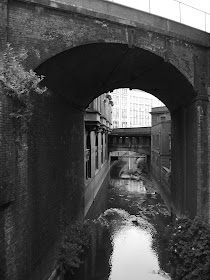Archaeology : Architecture : Art : Cold War : Curiosities : Design : Eccentricities : Ekco : Engineering : Industrial Heritage : Military : Petroliana : Photography : Shed Wonders : Transporter Bridges : Vintage Technology
02 July 2013
Manchester - Mad For It
Although Manchester has its roots in Roman times, when a fort was established near the junction of the River Irwell and the River Medlock - above, from Oxford Street - it owes its dominant feel to swift urbanisation in the early 19th century. A textile manufacturing boom led to the building of a great many factories that saw Manchester become the world's first industrial city, which status was granted in 1853.
The factories, small and large, were built of a dark red brick, often ornamented with terra-cotta detailing. Many of these have been cleared, or converted into loft apartments, but the seemier side of the city is just around the corner. Soap Street, above, is in the heart of the Northern Quarter.
Close to the Arndale Centre, of the 1970s, are a number of commercial premises that, whilst they might look like something straight out of a Dickensian portrait of the industrial city, are very much in business today, such as the office furniture store on Withy Grove, and a comic emporium that could be of New York.
Friedrich Engels lived in Manchester for two years from 1842, writing The Condition of the Working-Class in England. Vibrant and in parts exceedingly affluent, the city streets are yet home to many who have nowhere else to go. Engels would assuredly recognise as of Manchester scenes such as that under the railway arches near Charles Street, below.
Manchester's layout is largely dictated by its railways, rivers and canals. The Rochdale Canal runs dark under later buildings carried upon stilts, hard by the Piccadilly Basin. Numerous police notices read: "It is an offence for any person to engage in public acts of lewd, obscene or sexual behaviour. Anyone found committing any such act could be arrested and prosecuted." Manchester - all human life is here.






No comments:
Post a Comment